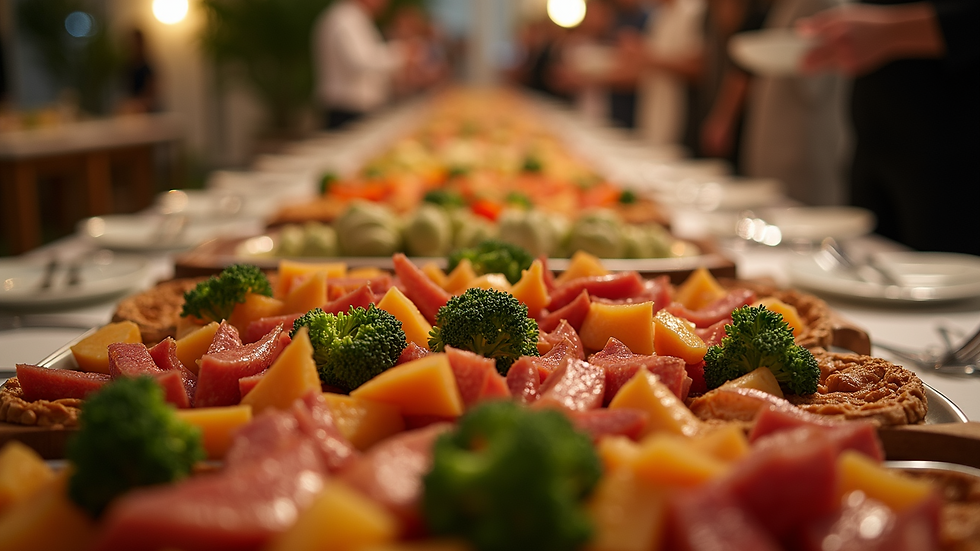A Closer Look at Cultural Elements of Indian Weddings
- Omkar Tamke

- Jul 28
- 4 min read
Indian weddings are a vibrant tapestry of culture, tradition, and sheer opulence. They are not just a union of two individuals, but rather a harmonious celebration of families, cultures, and beliefs. Each wedding is unique, showcasing various rituals that reflect the diverse traditions of India. From the intricate ceremonies to the sumptuous feasts, let’s take a closer look at the extraordinary cultural elements that characterize Indian weddings.
Indian Weddings: A Melting Pot of Traditions
Indian weddings vary widely across regions, religions, and communities. Each tradition carries its own significance, celebrating the couple's journey and the joining of two families. For example, in Hindu weddings, you might find the saat phere or seven circles around a sacred fire, symbolizing the couple's commitment to stand by each other through all of life's challenges.
Another popular ritual is the Mehndi ceremony, where intricate henna designs are applied to the bride's hands and feet. This beautiful ceremony not only enhances the bride's beauty but also serves as a day of joy and celebration for both families. The patterns symbolize auspiciousness and good fortune, making it a beloved pre-wedding tradition across India.

The significance of these rituals goes beyond mere aesthetics. They are steeped in meaning and serve as a way to impart blessings from the older generation to the younger ones.
The Craftsmanship of Attire: A Key Element
The attire worn by brides and grooms is another cultural hallmark of Indian weddings. In most cases, brides don elaborate lehengas or sarees adorned with intricate embroidery and embellishments. These outfits are often passed down through generations, making them treasures that carry their own stories.
For the groom, traditional attire typically includes a sherwani or kurta, often paired with a turban known as a pagdi. The variety of fabrics, colors, and designs can be overwhelming, but they play a very important role in showcasing cultural heritage.

Moreover, the choice of clothing often reflects not just personal style but also family heritage. It is not uncommon for outfits to be custom-made, designed to represent the family's history while adhering to modern trends.
Can a Girl Get Married During Periods in Hindu?
In traditional Hindu households, it is often considered inauspicious for a girl to get married while she is menstruating. Many families adhere to this belief due to a combination of cultural practices and ancient texts that suggest that a woman during her periods should not participate in sacred rituals. However, this notion is slowly shifting with modernity.
Numerous couples today question these outdated norms and prioritize their emotional and personal needs over societal expectations. Ultimately, the decision should lie with the couple and their families, focusing on what feels right for them rather than strictly adhering to traditional beliefs.
This cultural evolution reflects broader changes in society where conversations about menstruation are becoming more open and less stigmatized.
Food and Festivities: An Integral Part of the Celebration
Good food is at the heart of any Indian wedding. The cuisine varies widely, influenced by regional flavors and the cultural background of the couple. A typical wedding feast may include a variety of dishes, from biryani and kebabs to sweets like gulab jamun and jalebi.
In some cultures, a vegetarian menu is customary, while others offer a range of non-vegetarian options. Buffets can stretch for miles, featuring live cooking stations where chefs prepare dishes on the spot, adding a theatrical element to the meal.

Beyond just satisfying hunger, food serves as a medium through which families bond. Guests often share meals, engage in conversations, and experience the warmth of hospitality, which is a core aspect of Indian culture.
Rituals of Blessing and Good Fortune
The significance of rituals in Indian weddings goes beyond mere formality; they are integral to invoking blessings from deities and ancestors. Rituals like the Saptapadi (the seven steps) and Kanyadaan (giving away the bride) symbolize profound cultural values.
The Saptapadi, where the couple takes seven vows while walking seven steps together, highlights the importance of companionship and partnership. Conversely, Kanyadaan is a powerful moment that represents the father's blessing to the groom, entrusting his daughter to her husband. These rituals not only reinforce the couple's commitment to one another but also signify the values and beliefs that both families share.
As the couple navigates through various ceremonies, friends and family shower them with gifts, blessings, and, of course, love. Each ritual unfolds as a testament to the culture's rich beliefs regarding marriage, family, and unity.
The Future of Indian Weddings: Embracing Change
While Indian weddings are etched in tradition, they are also evolving with the times. Modern couples are blending traditional elements with contemporary influences. You might see a traditional ceremony at a venue adorned with modern decor, combining the best of both worlds.
Sustainability is also becoming a focal point for many couples. Eco-friendly decorations, sustainable catering, and minimized waste are increasingly common as couples seek to lessen their environmental impact while celebrating their love.
As we move forward, it is crucial to strike a balance between honoring traditions and embracing contemporary values. Each wedding is an opportunity for both the couple and their families to reflect on their values while building new traditions that resonate more deeply with their beliefs.
In exploring indian wedding traditions, we find a rich history that continuously shapes present-day celebrations, offering a glimpse into the diversity of Indian culture and the beloved rituals that make each wedding unique.
Through cultural elements, food, and the warmth of relationships, Indian weddings remain a celebration of love, commitment, and unity that transcends generations. Whether steeped in tradition or embracing the modern, these celebrations bring families closer while creating memories that last a lifetime.


Comments